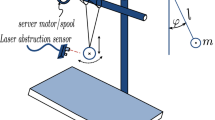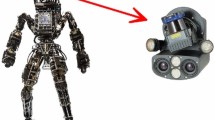Abstract
In this paper the application of robust control to a 5-link biped robotic model is investigated through the sliding mode approach, and compared to pure computed torque control. The biped consists of five links, namely the torso and two links in each leg. These links are connected via four (two hip and two knee) rotating joints which are considered to be friction-free and driven by independent d.c. motors. The locomotion of the biped is assumed to be constrained on the sagittal plane. The paper provides a full derivation of the biped dynamic model (single-leg support phase, biped-in-the-air phase) and an outline of the computed torque and sliding mode control algorithms. The simulation results were derived with two sets of parameters (one of which corresponds to a human-sized biped) and several degrees of parametric uncertainty (from 10% to 200%). In all cases the results obtained through the sliding mode control were much better than those obtained with the computed torque control. This superiority was shown to become stronger as the degree of uncertainty and the size of the biped increases.
Similar content being viewed by others
References
Raibert, M.: Legged Robots that Balance, MIT Press, Cambridge, MA, 1986.
Chow, C. K. and Jacobson: Further studies of human locomotion: Postural stability and control, Math. Biosci. 15 (1972), 93–108.
Hemami, H., Wil, C. and Goliday, G. L.: The inverted pendulum and biped stability, Math. Biosci. 34 (1977), 95–110.
Hemami, H. and Katbab, A.: Constrained inverted pendulum model for evaluating upright postural stability, ASME J. Dyn. Syst. Meas. Contr. 104 (1982), 343–349.
Mochon, S.: A mathematical model of human walking, Lectures on Mathematics in Life Sciences, Vol. 14, Amer. Math. Soc., 1981.
Hemami, H., Zheng, Y. F. and Hines, M. J.: Initiation of walk and tiptoe of a planar nine-link biped, Math. Biosci. 61 (1982), 163–189.
Miura, H. and Shinoyama, I.: Dynamic walk of a biped, Intl. J. Robotics Res. 3(2) (1984).
Furusho, J. and Masubuchi, M.: Control of a dynamic biped locomotion system for steady walking, ASME J. Dyn. Syst. Meas. Contr. 108 (1986), 111–118.
Furusho, J. and Masubuchi, M.: A theoretically motivated reduced-order model for the control of dynamic biped locomotion, ASME J. Dyn. Syst. Meas. Contr. 109 (1987), 155–163.
Yamada, M., Furusho, J. and Sano, A.: Dynamic control of walking robot with kickaction, Proc. 1985 Intl. Conf. on Advanced Robotics (ICAR'85), pp. 405–412, Tokyo (1985).
Sano, A. and Furusho, J.: 3D steady walking robot with kick-action, Proc. 1988 USA-Japan Symp. on Flexible Automation, Vol. II, Minneapolis, July 1988.
Mita, T., Yamguchi, T., Kashiwase, T. and Kawase, T.: Realization of a high speed biped using modern control theory, Int. J. Control 40 (1984), 107–119.
Takanishi, A., Egusa, Y., Tochizawa, M., Takeya, T. and Kato, I.: Realization of dynamic biped walking stabilized with trunk motion, Proc. Rob. Manuf. Syst. '88, September 1988.
Slotine, J. J.: The robust control of robot manipulators, Int. J. Robotics Res. 4(2) (1985).
Slotine, J. J. and Spong, M. W.: Robust robot control with bounded input torques, Int. J. Robotics Res. 2(4) (1985).
Slotine, J. J. and Li, W.: Applied Nonlinear Control, Prentice Hall (1991).
Zheng, Y. F. and Hemami, H.: Mathematical modeling of a robot collision with its environment, Int. J. Robotics Res. 2(3) (1985), 289–307.
Hemami, H. and Zheng, Y. F.: Dynamics and control of motion on the ground and in the air with application to biped robots, J. Robotic Systems 1(1) (1984), 101–116.
Walker, M. W. and Orin, D.: Efficient dynamic computer simulation of robot mechanisms, ASME J. Dyn. Syst. Meas. Control 104 (1982), 205–211.
Luh, J. Y. S., Walker, M. W. and Paul, R. P. C.: On-line computational scheme for mechanical manipulators, ASME J. Dyn. Syst. Meas. Control 102 (1980), 69–76.
Zheng, Y.-F.: The study of a nine link biped model with two feet, M.Sc. Thesis, The Ohio State University (1980).
Sias, F. R. Jr. and Zheng, Y.-F.: How many degrees-of-freedom does a biped need? Proc. IEEE Intl. Workshop on Intelligent Robots and Systems (IROS'90), pp. 297–302 (1990).
Tzafestas, S. G., Dritsas, L. and Kanellakopoulos, J.: Robust robot control: A comparison of three techniques through simulation, in P. Breedverld et al. (eds), Modeling and Simulation of Systems, J. C. Baltzer Co., 1989, pp. 255–260.
Tzafestas, S. G.: Adaptive, robust and rule-based control of robotic manipulators, in S. G. Tzafestas (ed), Intelligent Robotics Systems, Marcel Dekker, 1991, pp. 313–419.
Jaworska, I. and Tzafestas, S.: Robust stability analysis of robot control systems, Robotics and Autonomous Systems 17 (1991), 285–290.
Tzafestas, S. G.: Task grouping and scheduling for parallel processing, in T. Ono and F. Kozin (eds), Systems and Control-Topics in Theory and Applications, MITA Press, 1991, pp. 401–419.
Author information
Authors and Affiliations
Rights and permissions
About this article
Cite this article
Tzafestas, S., Raibert, M. & Tzafestas, C. Robust sliding-mode control applied to a 5-link biped robot. J Intell Robot Syst 15, 67–133 (1996). https://doi.org/10.1007/BF00435728
Received:
Issue Date:
DOI: https://doi.org/10.1007/BF00435728




